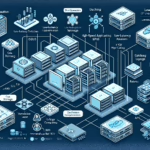Configuring IT infrastructure for low-latency applications requires careful planning, optimization, and the use of specialized technologies to minimize delays and maximize performance. Below are key steps to design an infrastructure optimized for low-latency applications:
1. Hardware Optimization
- High-Performance Servers: Use servers with fast CPUs, high clock speeds, large cache sizes, and multi-core architectures optimized for parallel processing.
- High-Speed Memory: Deploy DDR4/DDR5 RAM with low latency and high bandwidth. Ensure sufficient memory for your workload to avoid swapping.
- NVMe SSDs: Replace traditional storage drives with NVMe SSDs for faster data access and reduced I/O latency.
- GPU Acceleration: For AI, ML, or data-intensive workloads, use GPU cards like NVIDIA A100 or AMD Instinct for accelerated computing.
- Network Interface Cards (NICs): Use high-speed, low-latency NICs with RDMA (Remote Direct Memory Access) support for network communication.
2. Network Optimization
- High-Bandwidth Connections: Invest in 10GbE, 25GbE, or 100GbE network interfaces for high-throughput communication.
- Low-Latency Switches: Use high-performance switches with low-latency features and minimal packet processing overhead.
- Dedicated Network Paths: Implement a dedicated network for latency-sensitive applications to avoid congestion.
- Quality of Service (QoS): Configure QoS settings to prioritize traffic for low-latency applications.
- Edge Computing: Deploy infrastructure closer to end-users or data sources using edge computing to reduce latency.
3. Virtualization and Containerization
- Bare-Metal Servers: Avoid virtualization overhead by deploying applications directly on bare-metal servers for critical low-latency workloads.
- Optimized Kubernetes Configurations: For containerized applications, configure Kubernetes clusters with:
- CPU pinning and NUMA-aware scheduling.
- Reduced pod overhead and tuned resource limits.
- Hypervisor Tuning: If virtualization is needed, use lightweight hypervisors like KVM or optimize VMware ESXi for performance.
4. Operating System and Kernel Tuning
- Linux Kernel Optimization: For Linux servers, enable real-time kernel features and reduce kernel scheduling latency.
- Disable Unnecessary Services: Turn off non-essential services or daemons to free up resources.
- IO Scheduler Tuning: Use
noopordeadlineschedulers for disk I/O to prioritize latency. - Transparent Huge Pages: Disable or tune transparent huge pages (THP) to minimize memory allocation delays.
5. Application-Specific Optimizations
- Distributed Computing: Use frameworks like Apache Kafka, RabbitMQ, or Redis to optimize message queues and event processing.
- Parallel Processing: Optimize applications to take advantage of multi-core and multi-threaded processing.
- Database Tuning: Tune database configurations for high performance with caching, query optimization, and indexing.
6. Backup and Storage Optimization
- Cache and Tiering: Implement caching mechanisms and tiered storage to prioritize frequently accessed data.
- Distributed File Systems: Use high-performance distributed file systems like Ceph or Lustre for scalable storage.
- Latency-Aware Backup Solutions: Ensure backups are configured to avoid interference with application performance (e.g., use snapshots or asynchronous replication).
7. Monitoring and Analytics
- Real-Time Monitoring: Deploy tools like Prometheus, Grafana, and ELK Stack to monitor latency metrics and identify bottlenecks.
- Network Performance Tools: Use tools like Wireshark or SolarWinds to analyze packet flows and troubleshoot network latency.
- Application Performance Monitoring (APM): Use APM tools like Dynatrace, New Relic, or AppDynamics to monitor application latency.
8. AI and Machine Learning Integration
- Inference Optimization: For AI workloads, optimize inference performance with low-latency frameworks like NVIDIA Triton Inference Server or TensorRT.
- GPU Resource Sharing: Use Kubernetes GPU scheduling to allocate GPU resources efficiently for AI workloads.
- Model Deployment: Ensure models are deployed close to data sources or edge locations to reduce latency in prediction.
9. Security Measures
- Firewall Optimization: Use low-latency firewalls that minimize packet inspection delays.
- Encryption Performance: Optimize encryption algorithms with hardware accelerators like AES-NI or TLS offloading on NICs.
- Access Control: Implement fast authentication mechanisms that don’t introduce latency.
10. Scalability and Redundancy
- Horizontal Scaling: Design the infrastructure to scale horizontally across multiple nodes to distribute load and reduce latency.
- Load Balancers: Use high-performance load balancers like HAProxy or hardware-based solutions.
- Failover Mechanisms: Implement redundant paths and failover mechanisms to maintain availability during outages.
11. Edge and Cloud Integration
- Edge Computing: Deploy edge nodes to process data closer to the source, reducing latency for applications like IoT and streaming.
- Hybrid Cloud: Leverage hybrid cloud solutions with low-latency connectivity between on-premises and cloud environments.
- Direct Cloud Connectivity: Use services like AWS Direct Connect or Azure ExpressRoute for low-latency cloud access.
By combining optimized hardware, software, network, and application configurations, you can create an IT infrastructure that meets the demands of low-latency applications effectively. Regular monitoring and continuous improvement are essential to maintain peak performance.

